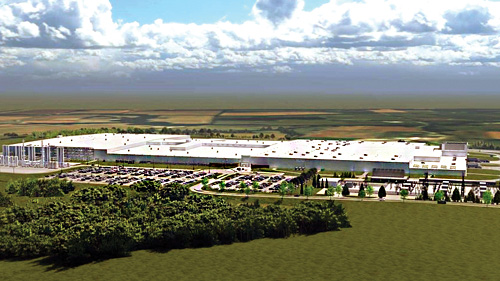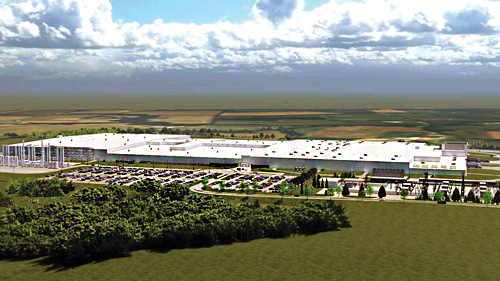
E
Prioritizing needs, identifying unique site constraints, and getting the right people involved from the get-go will ensure the long-term success of your operation.
Q1 2023

When looking for the perfect location for EV battery manufacturing operations, it’s important to understand the search necessitates an efficient and methodical evaluation process. Our Industrial team has been down this path numerous times, and the following represent the top-four site selection considerations we have learned to keep top of mind.
Consideration
No. 1: Prioritize Your Needs
- Related operations — An important piece of the site location puzzle is determining how your plant is going to function in relation to other operations. Obviously, these batteries will go into electric vehicles. So, where is the car manufacturing facility located in proximity to the prospective site? Where will the raw materials needed to manufacture the batteries come from? How will you transport between facilities?
- Workforce needs — The production of EV batteries will require a specialized labor force that fits the needs of the location as well as your facility.
- Local or state incentives — To attract companies, local economic boards and state governments often offer incentives that weigh heavily in terms of deciding where you should base your operation. It’s important to be aware, however, that the overall cost of a property of this scale can be so great that even the most enticing of tax incentives may not make it worth your while.
- Size of the investment — How big is the facility in terms of square footage and acreage? Also, what is a realistic project budget?
- Future growth — This can be somewhat of a guessing game for manufacturers, but it pays to have a plan for future growth up front. When do you anticipate needing to expand and how big will that expansion be? How will you plan for future manufacturing technologies, some of which have yet to be fully understood?
- Assign priorities to a wish list — You’re going to have a veritable laundry list of “must-haves” and should assign a factor of importance to each of those items since you’re most likely going to be comparing multiple sites and compromising on some of your wishes. Determine what’s most important to the stakeholders and establish a logical way to evaluate each of the different options.
Consideration
No. 2: Highlight Unique Constraints
- Utility demands versus available capacity — Not every region can effectively handle the enormous utility demands of EV battery plants. Even if a site can potentially provide capacity or availability of utilities, it may require massive upgrades or utility line extensions that yield a high cost or involve a protracted schedule. It’s important to know up front how much time and money those additional projects will cost for each potential site.
- Access — Transportation infrastructure is critical. What modes of transportation will you use to bring in raw materials and ship out finished products? Where is your workforce coming from? How much of the infrastructure needed already exists and how much do you need to build?
- Environmental concerns — An early assessment of environmental risks is critical. This may include weather and climate threats such as flooding and tornadoes; it can also involve site constraints of existing natural resources like wetlands and streams that require special permitting. Weather can affect how and when you work. Consider the potential impact to the construction project and the long-term resilience of the facility.
- Entitlements and permitting — Even when the local community is welcoming your project and the jobs it brings with open arms, you still must play by the rules. Each jurisdiction is different and will have its own unique process of project approvals to turn an expansive piece of agricultural land into the site for a state-of-the-art manufacturing facility. Because this process can have a big impact on the project cost and timeline, create a detailed plan for the required approvals during the site selection process. There may be site-specific permitting requirements, community engagement, negotiations, trade-offs, and multiple levels of government involvement.
- Land acquisition — Allow adequate time for the land purchasing process. Are multiple landowners involved? What if you need more property or easements than you first anticipated?
- Costs of improvements — Construction cost has always been important, but cost escalation over the last few years has made budgets much harder to manage, with the COVID-19 pandemic and subsequent supply chain shortages playing heavily into that. Although challenging, having a clear picture of unique site construction considerations and overall project costs is critical. You should aim to identify special equipment needs, long lead materials, and local impacts to availabilities and costs. Having a contractor engaged in the early stages can pay huge dividends.
An important piece of the site location puzzle is determining how your plant is going to function in relation to other operations.
Consideration
No. 3: Lay It Out
- Conceptualize site plans — This may be obvious, but you need to see a proposed layout of the site on paper. A picture is truly worth a thousand words, and nothing gets a team and stakeholders talking better than a good visual. Depending on the audience, you may need to consider renderings to better illustrate the project. This may be your most valuable piece of information to guide decisions — so do not skimp on it.
- Not all acreage is created equal — The shape of the property, presence of naturally occurring features, and relation to surrounding infrastructure can all drastically change the appeal of a property for your specific project. Some constraints may be obvious, like a stream running through the middle of the site, or less obvious, like endangered species or sinkholes. Take the time to study each property carefully and identify where site constraints lie within the context of the overall project before you make a site selection.
- Engage the major disciplines — The success of your project will come from a wide range of technical experts bringing their abilities together for a common goal. Although it can be tempting to make assumptions based on previous projects when you are in the site selection stage, it is wise to solicit input from across the team early, so you do not start the project overlooking crucial scopes of work. Consider contracting with a builder for preliminary services and insight in the initial concept planning.
- Plan for the unknown — Things change. A major part of the site selection process is aimed at identifying unknowns, but a big project like this is bound to surprise you more than a few times. You may have a carefully considered building plan (that’s great!) and a considerate long-term growth strategy (even better!), but much of this plan will likely be upended in the natural evolution of a complicated construction project. You can plan for this by making conservative assumptions, identifying backup options, and not getting trapped in the mindset of what you think you already know.
Not every region can effectively handle the enormous utility demands of EV battery plants.
Consideration
No. 4: Establish a Project Strategy — Early
This may be obvious, but you need to see a proposed layout of the site on paper.
- Set the stage — Site selection is one of the first project stages that brings together many separate parties for a common goal. Seize this opportunity to establish practices that will facilitate the site selection and serve as the foundation for the rest of the project to build upon.
- Organize team communication — As mentioned, soliciting input from design consultants and contractors at the early stages of the site selection process has its benefits. The more people involved in the project, the more important it is to have an organized framework of communication and documentation. Establish communication channels so everyone is working at their optimum.
- Speed is everything! — It seems everyone is working on an expedited timeline to manufacture the batteries that power in-demand electric vehicles. So, an aggressive schedule often trumps cost. Understand the importance of timely information and allocate the necessary resources.
- Early releases — Consider the risk/reward of early release design packages and early ordering of long lead procurement items — some of which may be affected by escalating costs or availability in a particular region. You may need to shift focus to accelerate the schedule.
- Track critical items — You have identified unique site constraints and potential roadblocks in your site evaluations. Some of these issues will be easily resolved, some will persist for many months, and some may become urgent problems. You must establish a system to track, assign priority, and elevate these crucial items. This must also include a clear understanding of the decision-making process and who has the authority to make decisions. Too many teams fail to properly track and organize important issues effectively. This list will start during or before the site selection and will continue throughout the entire project.
Soliciting input from design consultants and contractors at the early stages of the site selection process has its benefits.
A Vital Foundation
Setting out to establish an EV battery manufacturing facility is a highly complex, multilayered endeavor replete with numerous entities and countless individuals supporting its completion. What you do during the site selection process — which involves critical decisions that set the stage for every subsequent phase of the project — can ultimately make or break the success of your operation. As outlined in these top-four site selection considerations, setting processes, making key decisions, and getting the right people involved from the get-go creates a vital foundation that will support you through the entire life cycle of your project — and beyond.
-
Rob Whitson, Senior Civil Engineer, Gresham Smith
Rob Whitson is a senior civil engineer and project manager with 19 years of experience in site planning and design for a variety of project types. Based in Nashville, Tennessee, Rob serves clients throughout the United States in preliminary engineering services, construction design documents, and permitting. He specializes in navigating complicated agency regulations and approval processes to find the most effective and sustainable project solutions to meet unique client goals.











